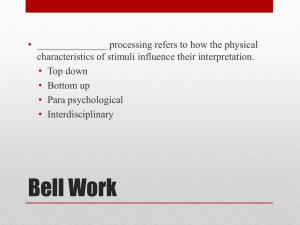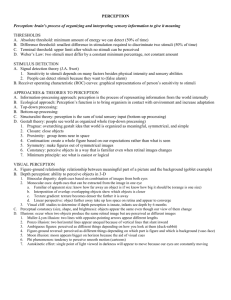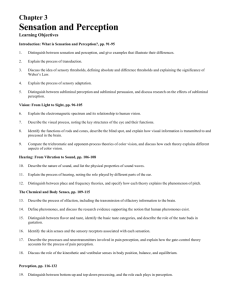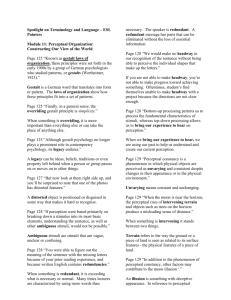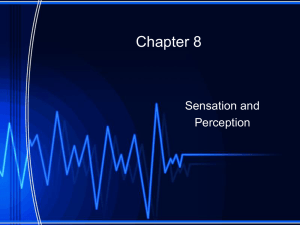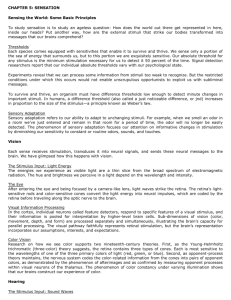sensation & perception
advertisement
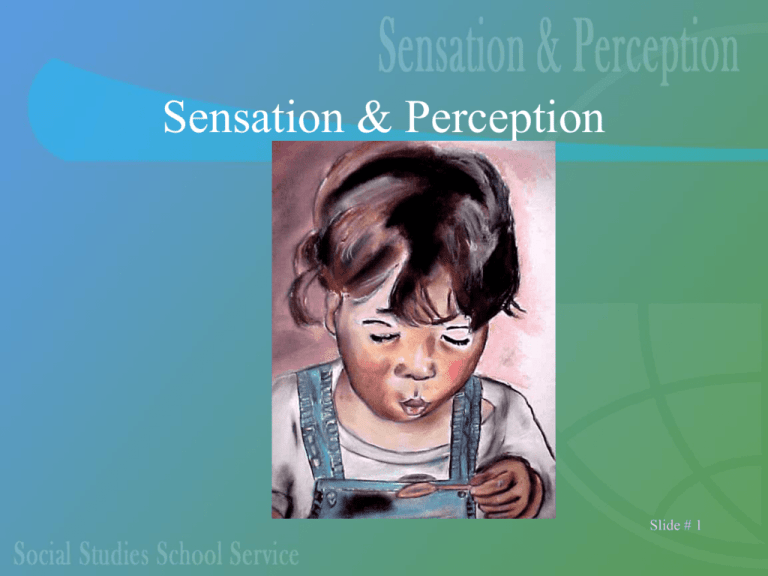
Sensation & Perception Slide # 1 An Introductory Activity • Researchers have found that our • experiences influence our perceptions Look at the following photographs or drawings and write a short description of each Slide # 2 Slide # 3 Slide # 4 Slide # 5 Slide # 6 Slide # 7 What Is Sensation? • It occurs when a • stimulus activates a sensory receptor A stimulus is measured by the following: size, intensity, duration, wavelength Slide # 8 What Is Perception? • The organization of sensory information • into meaningful experiences Psychophysics Slide # 9 Gustav Fechner • Created experiments that measured sensory data • Laid the basis for psychophysics Slide # 10 What Is Meant by a Threshold? • Absolute threshold: the smallest amount of a stimuli that a person can reliably detect Slide # 11 Absolute Thresholds • Vision: a flame from a • • • • single candle 30 miles away Hearing: ticking of a watch 20 feet away Taste: one teaspoon of sugar in two gallons of water Smell: one drop of perfume in a small house Touch: the wing of a bee brushing your cheek Slide # 12 Difference Threshold • The minimal difference in the magnitude of • energy needed for people to distinguish between two stimuli Weber’s law and experts Slide # 13 Sensory Adaptation • Senses are most • responsive to increases and decreases rather than ongoing unchanging stimulation Our senses have the ability to adapt Slide # 14 Signal-Detection Theory • The study of people’s tendencies to make correct judgments in detecting the presence of stimuli Slide # 15 The Stroop Effect A B Slide # 16 Processing Stimuli • Preattentive process • extracts information automatically and simultaneously when presented with more than one stimulus • Attentive process • considers only one stimulus at a time Slide # 17 The Senses Slide # 18 Vision • • • Pupil: the opening in the iris that regulates the amount of light Lens: the flexible and transparent part of the eye that changes its shape to focus light in the retina Retina: the innermost coating of the back of the eye Slide # 19 Slide # 20 The Human Eye: Rods and Cones • Cones require more • light than rods and work best in daylight Rods are more important for night vision Slide # 21 The Fovea and the Blind Spot • • • Fovea: the part of the retina that corresponds to the center of our gaze Blind spot: the part of the retina where the optic nerve leaves the eye Nearsighted vs. farsighted Slide # 22 Visual Pathways to the Brain • • Input from the right half of the visual field strikes the left side of each retina and is transmitted to the left hemisphere (shown in red) Input from the left half of the visual field strikes the right side of each retina & is transmitted to the right hemisphere (shown in green) Slide # 23 Slide # 24 David Hubel • • • Won the Nobel Prize for his work on how humans transform sensory information Planted electrodes in a cat’s visual cortex Feature detection Slide # 25 Light • The visible portion of the electromagnetic • • spectrum The colors we see are different wavelengths of light We see color when light waves hit objects and bounce back to us at varying speeds Slide # 26 Color Deficiency • Occurs when a person’s cones do not • function properly Different types of color deficiency: A. Some see certain colors B. Totally color deficient Slide # 27 Color Vision • • Color receptors in the retina transmit messages to the brain when visible lights having different wavelengths stimulate them Hermann von Helmholtz Slide # 28 Thomas Young’s Work • • • The three primary colors of light (red, green, blue) combine to form white Young showed that you could create any color of light by mixing these component colors and varying their brightness Trichromatic theory Slide # 29 Afterimages Slide # 30 Complementary Afterimage Slide # 31 Hearing • • • Depends on sound waves or vibrations Sound waves pass through various bones in the inner ear Thin, hair-like cells move back and forth Slide # 32 Loudness • • • Decibels: measures of loudness Each 10-decibel increase makes a sound 10 times louder Sound travels through the air at 1130 feet per second Slide # 33 Pitch • • The highness or lowness of a sound that corresponds to the frequency of a sound wave The ear senses sound waves that vary from 20 to 20,000 cycles per second Slide # 34 The Path of Sound • • • Sound waves are funneled by the outer ear to the eardrum, causing it to vibrate Ossicles and oval window, cochlea Basilar membranes, Organ of Corti, hair-cell receptors Slide # 35 Hearing Loss • • • 30 million Americans have hearing problems 2 million are deaf Causes: birth defects, disease, advanced age, injury, overexposure Slide # 36 Types of Hearing Loss • • Conduction deafness: caused by damage to the middle ear Nerve deafness: caused by damage to hair cells or the auditory nerve Slide # 37 Smell and Taste • • The chemical senses Nerve impulses travel through the olfactory nerve to the olfactory bulb in the brain, causing sensation of specific odors Slide # 38 The Olfactory Bulb • • • Located in the front of the brain above the nostrils Olfactory cortex is located in the temporal lobe Connections to the limbic system Slide # 39 Taste • • • Four basic tastes: sweet, sour, salty, bitter Food’s flavor results from these combinations: aroma, texture, temperature Taste cells, taste buds Slide # 40 Supertasters • • People who have greater taste sensibilities than others Supertasters have two to three times more taste buds than normal Slide # 41 Skin • • • The skin is the largest sensory organ Touch, pressure, warmth, cold, pain 1.5 million receptors for touch and pressure, somatosensory cortex Slide # 42 Pathways for Pain Signals • • • Receptors send pain signals to the brain along two pathways Gate control mechanism: incoming pain sensations must pass through a gate in the spinal cord that can be open or closed Endorphins, acupuncture Slide # 43 Kinesthetic • The sense of movement • • and one’s body is vestibular sense Receptors in muscles, tendons, joints Semicircular canals Slide # 44 Perception Slide # 45 A Changing Picture Slide # 46 Defining Perception • • • An active process The brain pieces together bits of sensory information in order to form orderly impressions or pictures Gestalt Slide # 47 Gestalt Principle #1: Proximity • “Meaningful wholes seem to precede parts and properties, as the Gestalt psychologists emphasized years ago.” –Anne Triesman Slide # 48 Gestalt Principle # 2: Similarity • When similar and dissimilar objects are mingled together, we see the similar objects as groups Slide # 49 Gestalt Principle # 3: Continuity • We tend to see continuous patterns, not disrupted ones Slide # 50 Gestalt Principle # 4: Simplicity • We perceive the simplest shapes possible Slide # 51 Gestalt Principle # 5: Closure • Occurs when people see a familiar pattern or shape with some missing parts Slide # 52 Perceptual Interference • Perceptions are not always based on sensory • information Perceptual interference: occurs when we fill in the gaps in what our senses tell us Slide # 53 Subliminal Perception • The Hidden Persuaders, Vance Packard • Sub (below); limen (threshold) • Subliminal messages • Congressional and FCC alerts Slide # 54 Subliminal Perception • The ability to notice • stimuli that affect only the unconscious mind Controversy and Brian Wilson Key Slide # 55 Subliminal Perception • The ability to notice • stimuli that affect only the unconscious mind Controversy and Brian Wilson Key Slide # 56 In the Eye of the Beholder • According to Key, • advertisers routinely place subliminal stimuli in their ads Subliminal self-help Slide # 57 Elizabeth Loftus • “Subliminal • perception is a genuine phenomena, amenable to and worthy of experimental investigation” (1992) Sexual inhibitions, buying patterns, Satan worshipers Slide # 58 U.S. Presidential Race • Commercial for • George Bush: use of a subliminal slur against Al Gore “Democrats smell a rat” Slide # 59 Two Types Of Stimuli • Distal • Proximal • Developing a perceptual hypothesis Slide # 60 Depth Perception • • • The ability to recognize distance and threedimensional images Binocular vs. monocular cues Retinal disparity and convergence Slide # 61 Monocular Cues • • Depth cues about distance are based on the image one eye or the other sees Six cues: interposition, height in plane, texture gradient, relative size, light and shadow, linear perspective Slide # 62 Slide # 63 Optical Illusions • • Perceptions based on inappropriate assumptions/discrepancy between the appearance of a visual stimulus and its physical reality Muller-Lyer illusion Slide # 64 Another Illusion • Roger Shepard (1990) • The Ames Room Slide # 65 An Impossible Figure • • Objects that can be represented in twodimensional pictures may not be able to exist in three-dimensional space Bottom-up processing Slide # 66 Perceptual Set Slide # 67 Two Modes of Processing • Hubel and Wiesel • Bottom-up • Top-down Slide # 68 Extrasensory Perception (ESP) • The ability to gain information by some • means other than the normal senses Paranormal phenomena and parapsychology Slide # 69 The “Sixth Sense” • The major focus includes the following: Telepathy, clairvoyance, precognition, and psychokinesis Slide # 70 Telepathy • Communication of thoughts from one mind to another that occurs without the use of our known senses Slide # 71 Clairvoyance • The ability to perceive objects and events without using the senses Slide # 72 Precognition and Psychokinesis • Precognition: the ability to foretell the • future Psychokinesis: the ability to move objects through mental effort alone Slide # 73 Theories of Perception: Practical Applications • Aviation psychology • Human-computer interaction Slide # 74
